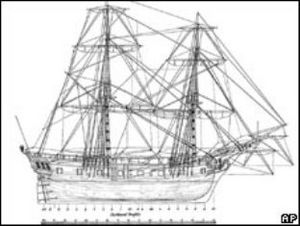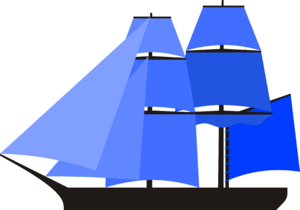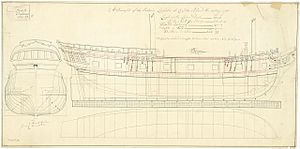HMS Ontario (1780) facts for kids

Ontario
|
|
Quick facts for kids History |
|
|---|---|
| Name | HMS Ontario |
| Namesake | Lake Ontario |
| Owner | Provincial Marine |
| Operator | Royal Navy |
| Builder | Carleton Island Dockyard |
| Laid down | October 1779 |
| Launched | 10 May 1780 |
| Fate | 31 October 1780 sank in Lake Ontario during a storm |
| Status | Shipwreck discovered in June, 2008 at more than 500 ft (150 m) depth |
| General characteristics | |
| Class and type | Sixth rate |
| Tons burthen | 226 tons |
| Length | 80 ft (24 m) |
| Beam | 25 ft (7.6 m) |
| Sail plan | Two-masted snow |
| Complement | 130 believed lost |
| Armament | 22 cannons |
The HMS Ontario was a British warship that sadly sank in a big storm on Lake Ontario on October 31, 1780. This happened during the American Revolutionary War, a time when America was fighting for its freedom from Britain. It was a special type of ship called a snow, armed with 22 cannons. At about 80 feet (24 m) long, it was the biggest British warship ever seen on the Great Lakes back then.
For over 200 years, the Ontario lay hidden at the bottom of the lake. But in 2008, its shipwreck was finally found! It was amazingly well-preserved in the cold, deep water. Experts say it's the oldest and most complete British warship ever discovered in the Great Lakes.
Building the Ontario
The Ontario was built in 1780 on Carleton Island. This island was a very important base for the British during the Revolutionary War. Today, Carleton Island is part of New York.
The ship was operated by the Royal Navy, which is Britain's navy. It was used by the Provincial Marine as an armed transport ship. This means it carried soldiers, supplies, and even prisoners.
The Ontario was launched into the water just five months before it sank. Even though it was a warship, it never actually fought in a battle. Its main job was to move things and people from one place to another in remote parts of New York.
The Storm and Sinking
The Ontario sank during a terrible storm on October 31, 1780. It was sailing from Fort Niagara to Oswego. Sadly, about 80 people were on board and were lost with the ship.
These people included sailors, officers, and soldiers from different British regiments. There were also some Native Americans and other passengers. For many years, the news of the Ontario's sinking was kept a secret. This was to hide the loss of such an important warship.
Finding the Lost Ship
People searched for the HMS Ontario for a very long time. In May 2008, they used special equipment called Side-scan sonar. This technology helps create images of the lake bottom. They found a promising shipwreck between Niagara and Rochester, New York. The water in this part of Lake Ontario is very deep, more than 492 feet (150 m)!
The sonar images clearly showed a large sailing ship sitting upright on the lakebed. It still had two masts reaching up about 70 feet (21 m) from the bottom. The detailed images even showed parts of the crow's nests on each mast. This strongly suggested it was the Ontario.
Because the wreck was so deep, divers couldn't reach it. So, in June 2008, they sent down a remotely operated underwater vehicle (ROV). This robot confirmed that it was indeed the HMS Ontario!
Experts believe that the cold, fresh water of Lake Ontario helped preserve the ship. There's also not much light or oxygen down there, which slowed down how quickly the ship broke down. That's why it was found mostly intact, even after being on the bottom for 230 years!
The people who found the wreck told the New York State Office of Parks, Recreation and Historic Preservation. However, the exact location of the shipwreck is kept secret. This is because the wreck still belongs to the United Kingdom and is considered a war grave, a special place where soldiers were lost.
See also
- Land Tortoise (shipwreck), another well-preserved old shipwreck in Lake George



